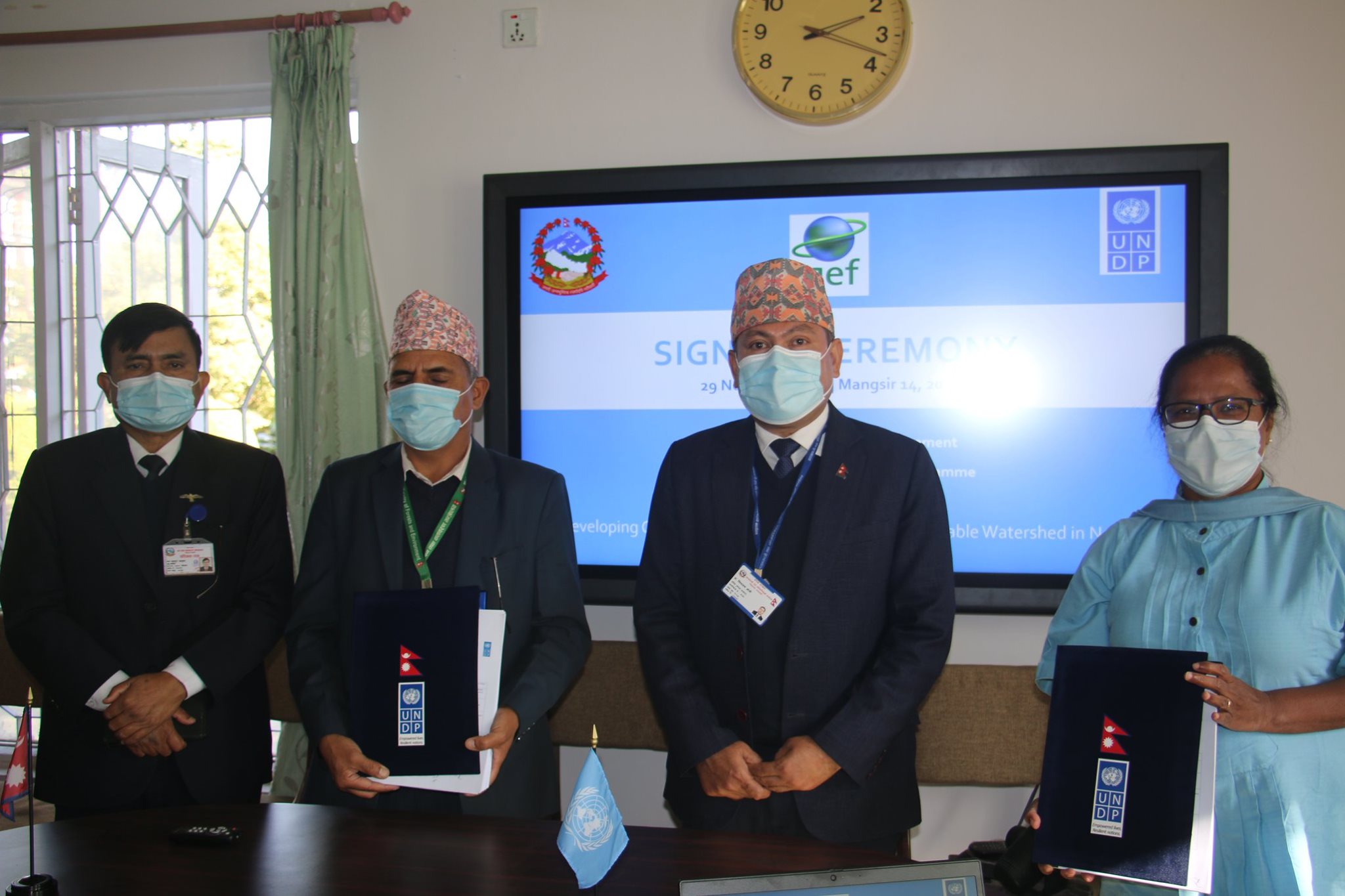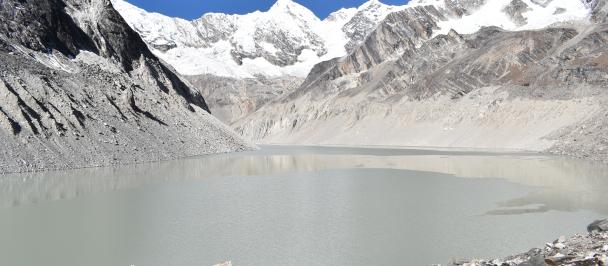Kathmandu, 29 November 2020 – The Government of Nepal and United Nations Development Programme (UNDP) and the Global Environment Facility Least Developed Countries Fund - today launched a new USD42 million climate adaptation project to help secure sustainable livelihoods and food security for vulnerable rural communities in east of the country.
Led by the Department of Forests and Soil Conservation, the project will introduce and scale-up integrated watershed management practices and climate-smart agriculture in four major watersheds (Dudhkoshi, Molung, LIkhu and Sunkoshi Canyon within the lower Sunkoshi basin) covering 782,68 square kilometres and benefiting some 121,606 people directly.
“With support from the GEF-Least Developed Countries Fund and UNDP, the government is pleased to see this important new project take flight today,” said Secretary of the Ministry of Forests and Environment, Dr. Bishwa Nath Oli. “The ministry is committed for the smooth implementation of the project and we have even started internal preparation for this. We know that people and the planet are intertwined, and that the health of our watersheds is crucial to the resilience of communities, both up and downstream. This project will unite stakeholders at all levels – from national government and local government to sectors to communities – to restore them, thereby helping secure lives and livelihoods into the future.”
Warming trends are increasing in Nepal’s highly vulnerable mountain regions, causing glaciers to melt at a faster pace than ever before. Rainfall is shifting. Communities face increasing floods, droughts and landslides with extensive economic, life and livelihood losses annually.
At the same time, agricultural production in the target watersheds has been falling drastically over recent years. As a result, seasonal and permanent migration is increasing, affecting village life significantly. The watershed processes that are important to sustain agriculture on already challenging topography and scarce land need to be brought back into equilibrium.
As well as focusing on enhanced watershed management, the project will strengthen hydrometeorological monitoring, while also investing in community involvement in land and resource management, including establishing community stewardship programmes and rolling out training to local forestry and water user groups.
In Nepal, COVID-19 has further complicated the challenges of climate change. While the spread of the pandemic has largely been contained outside of urban centres, rural communities are being impacted by its socio-economic fallout. The project will complete an analysis of how these flow on effects of COVID-19 will impact implementation and will support local government to make any adjustments necessary.
“The impacts of climate change add significant challenges to development”, and this project is timely, and this despite COVID-19 for us to work side by side the Government of Nepal, the Province 1 and the related municipalities around Khotang and Okhaldhunga and to safeguard the most vulnerable communities, their physical and economic assets from climate change induced disasters”, said UNDP’s Resident Representative in Nepal, Ayshanie Medagangoda Labe. “This is a continuity of what UNDP has been doing in Nepal to mainstream climate change adaptation and managing climate risks for a number of years, since development of National Adaptation Programme of Action,; through support for adaptation planning; reducing flood and glacial lake outburst risk and strengthening governance of climate finance . As Nepal is preparing for the enhanced NDC, ae are pleased to take a step ahead and continue our partnership and support for an Integrated watershed management approach, that will reinforce climate resilience, livelihoods of the men and women living in the vicinities of the 4 vulnerable watersheds of Sunkoshi river basin”
“We are delighted to see this important project launch with support from the Least Developed Countries Fund,” said Gustavo Fonseca, GEF Director of Programs. “Through this climate adaptation project, Nepal will improve its communities’ livelihoods and food security, while also sustainably managing vital ecosystems. It is a good example of the multiple benefits climate adaptation support can provide.”
The project supports Nepal’s ambitions set out under its 15th five-year plan, the Climate Policy 2019 as well as under international frameworks including the Sustainable Development Goals and its Nationally Determined Contributions under the Paris Agreement. A grant of USD 7 million from the Global Environment Facility and USD 0.9 million from UNDP join a national investment of USD 34,893,000 as co-financing from federal and local government. For more information, please visit this page.
For media inquires: Kamal Raj Sigdel, Head of Communications, UNDP Nepal kamal.sigdel@undp.org | Vijaya Singh, Assistant Resident Representative, UNDP Nepal vijaya.singh@undp.org | Keti Chachibaia, Regional Technical Advisor for Climate Change Adaptation, UNDP keti.chachibaia@undp.org |
About the United Nation Development Programme
UNDP partners with people at all levels of society to help build nations that can withstand crisis, and drive and sustain the kind of growth that improves the quality of life for everyone. On the ground in nearly 170 countries and territories, we offer global perspective and local insight to help empower lives and build resilient nations. www.undp.org
On climate change, UNDP has the largest portfolio in the UN system and works with over 140 countries around the world.
About the Least Developed Countries Fund
The Least Developed Countries Fund (LDCF) was established based on a 2001 decision from the United Nations Framework on Climate Change (UNFCCC), along with the Special Climate Change Fund (SCCF). Managed by the GEF, the LDCF supports least-developed countries in their efforts to adapt to the effects of climate change. To date, the LDCF has supported over 290 projects in least developed countries, with approximately $1.5 billion in grant resources. Its strategy draws on the track record of leaving no one behind; each and every least developed country has received LDCF support for adaptation efforts. The projects supported to date are expected to directly reduce the vulnerability of approximately 30 million people.
Additional notes for international version of release
Over 80% of Nepal’s population live in rural areas (World Bank, 2017).
Although Nepal has undergone major poverty reduction in recent decades, it remains one of the 48 least developed countries of the world, as designated by the United Nations.
Over a third of the country live in ‘multidimensional poverty’, with 25% of the population living below the national poverty line (UNDP Human Development Report)
Approximately 66.5% of the national population engages in agriculture (WB, 2017). A heavy reliance on agriculture – largely subsistence and rainfed farming – is a significant aspect of vulnerability in terms of climate change.
Floods and landslides have caused approximately 8,196 deaths in Nepal from 1971 to 2013, with an average of 195 deaths per year.

 Locations
Locations




